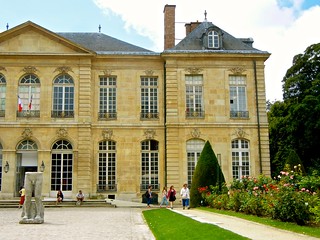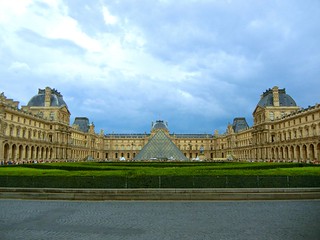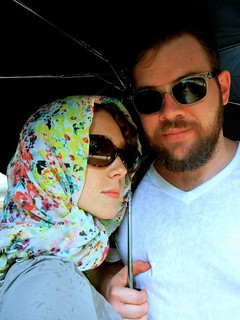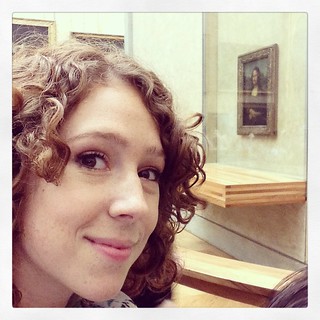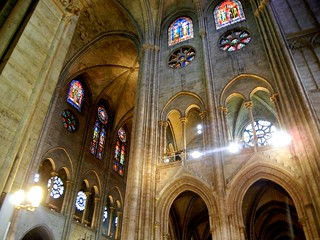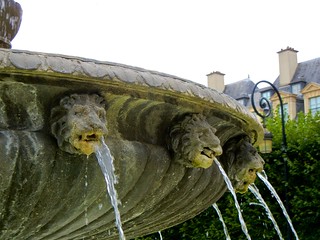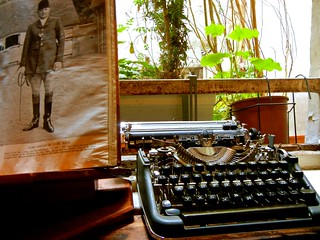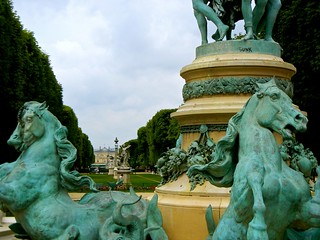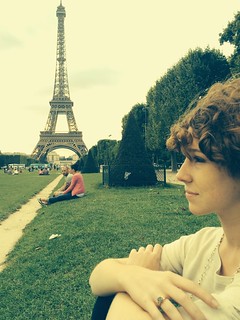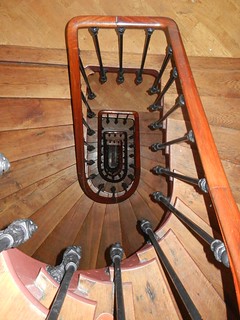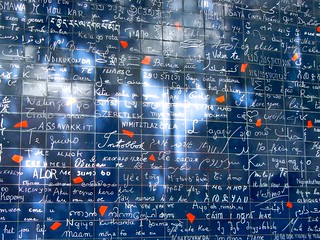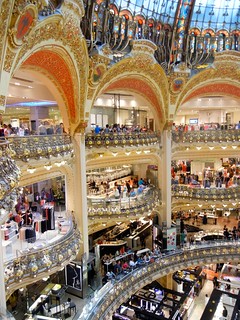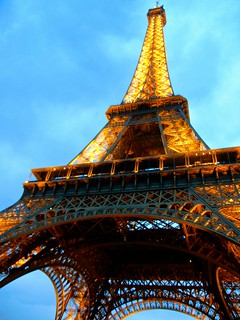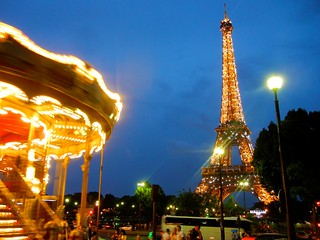Quick side note: I’ve uploaded three videos relevant to my last post. The first is of the Eiffel Tower lit up at night; the second is of an accordion player in the streets of Montmartre; and the third is of Nadia’s wonderful apartment…just in case a picture can’t speak quite as many words as I’d like.
While at dinner with a few professors from Hungary and Beijing during the IACCP conference, one asked my specific plans for Paris. I pulled up a PDF of our rough itinerary, handed it to her, and sat back, expecting yays or nays as she scrolled down the list. Instead, she sat back, tossed back her head, and let out a bark of laughter.
One of the plazas I specifically wanted to visit was the Place de la Concorde, next to which I had written, “place where they execute people -- yay!”
Face palm. Sometimes I assume my humor is easily understood by the broader population. And then I remember that it's not.
In any case, this was our first stop the next morning: We emerged from the metro station into a large roundabout dotted with gilded statues, grand fountains, and ornate streetlamps. It was the age-old site of the executions of Marie Antoinette, Louis XVI, Maximilien Robespierre, and many others.
A little anticlimactic when it now stands as a roundabout for little French cars the size of Great Danes.
 Sufficient research through TripAdvisor, Rick Steves, and many other resources pointed us to something called a Paris Museum Pass, which gave us a full 48 hours to visit as many museums and similar landmarks as we possibly could for a flat rate. (Spoiler alert: it was worth every Euro -- not only did we visit seven museums in those 48 hours, but we skipped to the front of every single one- or two-hour-long line.
Sufficient research through TripAdvisor, Rick Steves, and many other resources pointed us to something called a Paris Museum Pass, which gave us a full 48 hours to visit as many museums and similar landmarks as we possibly could for a flat rate. (Spoiler alert: it was worth every Euro -- not only did we visit seven museums in those 48 hours, but we skipped to the front of every single one- or two-hour-long line.
We started off with the Musée de l'Orangerie, a small museum when compared with d’Orsay and the Louvre, but which features Monet’s Water Lilies and many other famous works from Rousseau, Renoir, Modigliani, Utrillo (my surprising new top-5 favorite artists), and many others.
Side note: l’Orangerie was featured in Midnight in Paris. If I had access to a Redbox right now, I’d give that film another watch just for nostalgia’s sake, right here in front of our new favorite Amsterdam pub hangout (i.e., where I write this).
Our next stop was the Rodin museum, which featured hundreds of Rodin’s sculptures as well as a photography exhibit by Robert Mapplethorpe. If anyone knows anything about either artist, let’s just say that Ryan didn’t prepare me for what to expect here. I walked in in a caffeine-deprived haze, and within a few seconds I was wide awake. Even now, so close to Amsterdam’s Red Light District, very little fazes me anymore.
We enjoyed our first espressos of the day outside in the museum’s gardens, which were positively lovely. We sat under a line of arching trees, espressos and baguettes in hand, enjoying the perfect morning breeze.
From there, we headed to the Musée d’Orsay, one of the most renowned museums in France. The entrance looked like Grand Central Station with its curved glass ceilings and dozens of arched entrances along every wall, and hundreds -- hundreds -- of milling visitors. It was split by era and type of art, and we took our time exploring the collections and discussing what we saw in undertones.
A stroll through Tuileries Garden, which looks exactly like what you’d expect from an expansive garden in the middle of Paris, led us straight to the Louvre.
And before I discuss the Louvre, let me show a picture of the sight we faced:
We paused for pictures, took a few selfies, and then I turned Ryan and asked, in all seriousness, whether we could finish the Louvre in 30 minutes.
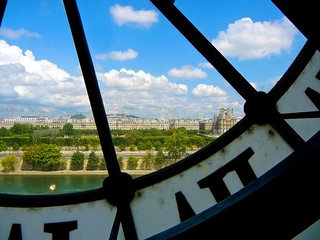 He looked down at me with the look he gives when he’s trying not to laugh and, in a constrained voice, asked if I realized how large the Louvre was.
He looked down at me with the look he gives when he’s trying not to laugh and, in a constrained voice, asked if I realized how large the Louvre was.
What I remembered from Dan Brown’s The DaVinci Code was a pyramid, and from what we could see only hundreds of feet away, the pyramid looked pretty damn small.
It also looked oddly empty -- no works of art visible through the glass at all.
Weird.
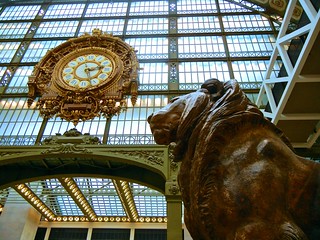 And it was only then that I found out that the 652,300-square-foot palace extending on three sides of the pyramid and far beyond it was not, in fact, a palace.
And it was only then that I found out that the 652,300-square-foot palace extending on three sides of the pyramid and far beyond it was not, in fact, a palace.
I knew the Louvre was a big deal. I didn’t realize it was the big deal -- a big enough deal to attract 9.7 million visitors each year, making it the most visited (and the largest) museum in the world.
Needless to say, after two full hours we’d only seen about 30% of the museum, and that was moving at a fast pace. The Mona Lisa, which is only 30”x20” and sits alone on a massive two-story-high white wall, drew at least a hundred visitors into that one small room, so that it became a survival of the fittest to reach the front of the line.
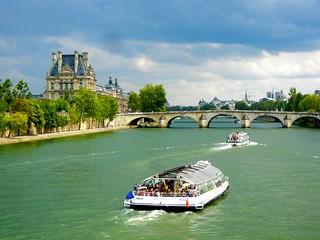 And once our feet were throbbing too much to continue, we descended into the Carrousel du Louvre beneath the pyramid, where we saw…
And once our feet were throbbing too much to continue, we descended into the Carrousel du Louvre beneath the pyramid, where we saw…
…an Apple Store. An Apple Store in the Louvre. It was like finding out that Wendy’s has a Poptart ice cream sandwich: two perfect things, served in a single heavenly place.
And so we collapsed on the floor and enjoyed our first Wi-Fi connection in a very, very long time for two tech-dependent people such as ourselves, and there we remained until security shooed us away.
After enjoying a macaron (rose for Ryan, salted caramel for me) at Ladurée, we made our way out of the Louvre and back into sunlight.
I’ll note here that I’m not a huge fan of French food.
Correction: I’m not a huge fan of cheap French food. And because I’m a grad student, I can only afford cheap French food.
We’re not talking French sweets or pastries -- I can tolerate virtually any kind of sweet or pastry, from a five-star crème brûlée to the trashiest of Moon Pies.
When in Reims for a week and a half, I thought I liked French food. Turns out that Reims, due to its proximity to Germany, boasts more German-based food than it does French food.
And as much as I hate to admit it, I really like pork products.
So after two days in Paris, I was missing German food…and within an hour of leaving the Louvre, we found ourselves in a flammekueche (read: German flatbread) restaurant, where I held my fork like a hammer while trying to hack away at my meal until giving up, wrapping my flatbread into a burrito, and gnawing at it like a cavewoman while Ryan covered his face with his hands.
That night, we met up with Ayse -- a good friend from summer school -- and her husband, John. We found a Route 66-themed restaurant with cheap meals and drinks and enjoyed the Parisian night, tree-lined street, and hilarious restaurant décor. (Let’s just say that it resembled Arizona…sixty years ago.)
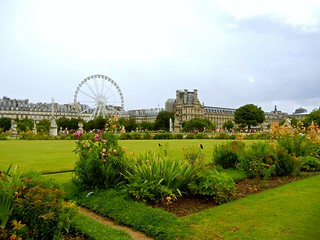 We began the next morning with a visit to the oldest public square in Paris, the Place des Vosges, circa 1605. We took a leisurely stroll around the historic buildings that looked down on the small square of grass and fountains before winding our way to the Conciergerie, which was one of those museums you don’t really think you need to see but afterward consider one of the coolest museums you ended up seeing. (There have been a few of those in Amsterdam, too. I might also just be a skeptic.) The Conciergerie boasted Marie Antoinette’s cell prior to her execution, the cells of many other prominent Parisian figures, and a historic part of the French royal palace. It stems from the 11th century, when it was used as the seat of France’s medieval kings.
We began the next morning with a visit to the oldest public square in Paris, the Place des Vosges, circa 1605. We took a leisurely stroll around the historic buildings that looked down on the small square of grass and fountains before winding our way to the Conciergerie, which was one of those museums you don’t really think you need to see but afterward consider one of the coolest museums you ended up seeing. (There have been a few of those in Amsterdam, too. I might also just be a skeptic.) The Conciergerie boasted Marie Antoinette’s cell prior to her execution, the cells of many other prominent Parisian figures, and a historic part of the French royal palace. It stems from the 11th century, when it was used as the seat of France’s medieval kings.
 Next door, surrounded by government buildings and the Palace of Justice, was Sainte-Chapelle -- yet another example of a severely underrated site.
Next door, surrounded by government buildings and the Palace of Justice, was Sainte-Chapelle -- yet another example of a severely underrated site.
Hands down, Sainte-Chapelle was more beautiful than the Notre Dame. Did it make me cry? No -- but it also wasn’t the site of one of my top two favorite Disney movies of all time. (I had this song stuck in my head for days, by the way.)
No, Sainte-Chapelle (video here) boasts some of the most beautiful stretches of stained glass I saw in France.
Next was the Notre Dame, which -- as I’ve just said without any trace of regret -- brought me to tears. We were lucky enough to arrive just before a service, and I happened to stand within feet of the procession (and the pope) as they made their way out of the sacristy and into the cathedral.
And our last evening in Paris was spent in a leisurely manner, strolling through the student-filled Latin Quartier and the expansive Luxembourg Gardens (video here). Had we known that Paris all but shuts down on Mondays, we would have had a much busier day -- but alas, Versailles and the Hunchback of Notre Dame-featured Catacombs will have to wait for Visit #2, hopefully in the not-terribly-far future.
However, that isn't to say our visit didn't end with a bang: I haggled a 45€ bottle of champagne down to 10€, which we shared while sitting on the lawn in front of the Eiffel Tower for one last time. We'd just finished our only sit-down dinner in France -- which was perfectly French in nature and still very affordable -- before forking over 2€ for banana-Nutella crêpes and making our way over to one of France's most well-known landmarks. We joined hundreds of other viewers for another sunset, another light show, and another beautiful end to a full day.
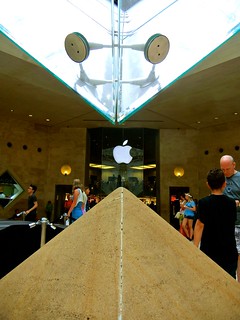 And thus concluded our lovely three days in Paris. In retrospect, as much as we loved this city (and as much as I loved my two weeks in France), we are head over heels in love with Amsterdam.
And thus concluded our lovely three days in Paris. In retrospect, as much as we loved this city (and as much as I loved my two weeks in France), we are head over heels in love with Amsterdam.
We love -- love -- this city.
And that will be a tale for another day.
Note: more pictures below
Notre Dame
Place des Vosges, Paris's oldest public square
The medieval portion of the Conciergerie
Sainte-Chapelle
One of the neatest bookstores I've ever seen, Shakespeare & Co.
Luxembourg Gardens (or perhaps 5% of it)

